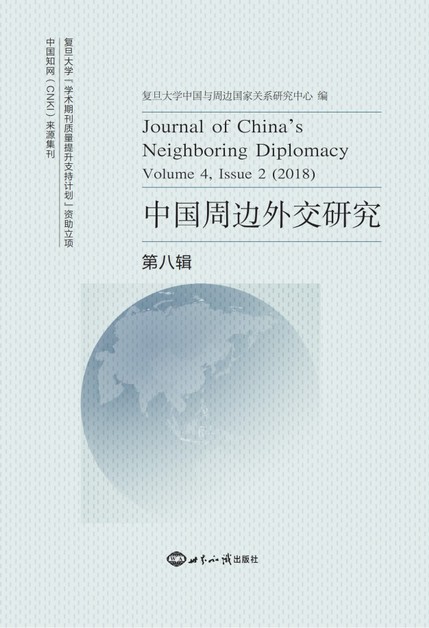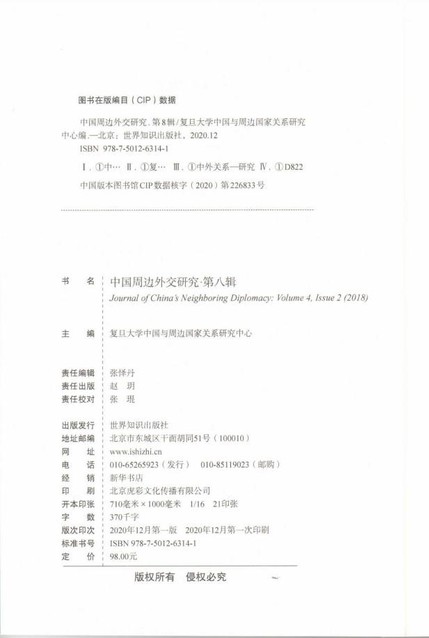|
|
The Title Page of Journal of China's Neighboring Diplomacy, Vol. 4, Issue 2 (2018) | The Copyright Page of Journal of China's Neighboring Diplomacy, Vol. 4, Issue 2 (2018) |
Center for China's Relations with Neighboring Countries of Fudan University (CCRNC-Fudan), ed, Journal of China's Neighboring Diplomacy, Vol. 4, Issue 2, 2018.
Publisher: World Affairs Press (China)
Published in December 2020.
ISBN: 978-7-5012-6314-1
Contents
Preface ...... Qi Huaigao / 1
China’s Neighboring Countries Studies Report II
New Perspective and New Visions of China’s Neighboring Countries Studies ...... Zhang Yunling / 11
China Needs New Theoretical Foundation in the New Era ...... Luan Jianzhang / 14
A Brief Introduction to the Relationship between Borderland Studies of China and China’s Neighboring Countries Studies ...... Xing Guangcheng / 17
China’s Neighboring Countries Studies should be based on Historical Research ...... Yu Weimin / 22
Four Dimensions of China’s Neighboring Countries Studies ...... Guo Dingping / 26
An Analysis of the Research Methods of China’s Neighboring Countries Studies-Case Study on Russia ...... Feng Yujun / 31
Comprehensive Studies on China’s Neighboring Diplomacy
The Retrospect and Prospect of China’s Neighboring Diplomacy during the Past 40 Years of Reform and Opening ...... Shi Yuanhua / 39
Top-level Design of China’s Neighboring Diplomacy in the New Era ...... Qi Huaigao / 72
The Cooperation Achievement and Challenges since the Establishment of China-ASEAN Strategic Partnership ...... Song Qingrun / 90
The Belt and Road Research
A Study on How to Construct a System of International Rules for Belt and Road Initiative in a Pragmatic Way ...... Mei Guanqun / 113
The Development of Party Politics in Southeast Asian Nations and the Belt and Road Initiative ...... Li Wen and Xu Liqun / 130
Current Conditions, Opportunities and Challenges of Chinese Investment in Laos in the Context of BRI ...... Yang Zhuojun / 148
Economic Cooperation of China’s Neighboring Areas
Evaluation and Analysis of the Progress of Indonesia’s “Sea Highway” Program ...... Wu Chongbo / 173
New Background of the Mekong River Sub-regional Cooperation and the Role of Vietnam ...... Bui Thi Thu Hien / 191
Security Studies of China’s Neighboring Areas
The Options of East Asian Peacekeeping Models and China’s Participation ...... Wang Tao / 209
China’s Role in the Crisis Management and Control of Its Neighboring Areas: a Case Study on the Korean Nuclear Crisis ...... Qiu Fahua / 224
The Security Situation of Northern Afghanistan and Its Impact on China ...... Zhu Yongbiao and Wei Lijun / 235
Cultural Exchanges of China’s Neighboring Areas
Review on Public Diplomacy of China toward Kazakhstan under the Construction of Community of Common Destiny ...... Qin Haibo, Gao Xiaosheng and Li Lili / 251
Country Studies of China’s Neighboring Areas
Concentric Circle and its Influence on Indonesia’s Foreign Strategy ...... Xue Song / 271
Reviews on Symposiums
A Review on the Symposium of “China’s Neighboring Countries Studies and its Discipline Construction” ...... Hu Yangyu / 291
A Review on the International Symposium of “ASEAN-China Energy and Resources Cooperation in the Diamond Decade” ...... Xu Qin and Dong Yi / 299
A Review on the Symposium of“the Belt and Road Initiative and ASEAN-China Cooperation” ...... Xue Song / 307
Appendix
Annuouncement of Journal Name Change ...... 315
Introduction on Center for China’s Relations with Neighboring Countries of Fudan University (CCRNC-Fudan) ...... 316
Notice Inviting Contributions to the Journal of China’s Neighboring Diplomacy ...... 318
Standards of Articles and Annotations of the Journal of China’s Neighboring Diplomacy ...... 320
The Retrospect and Prospect of China's Neighboring Diplomacy during the Past 40 Years of Reform and Opening
Shi Yuanhua
Abstract: During the past 40 years of reform and opening, China has been emerging as the 2nd largest economy of the world, and the neighboring areas of China have become the most important external region that may have the most outstanding effect on the revitalization of the Chinese nation. This paper makes a retrospect on the evolution of China's neighboring diplomacy since the beginning of the Reform and Opening, and takes a review on the continuation and development of Chinese leaders' thoughts and ideas for neighboring diplomacy, with a focus on the new perceptions, mentality, and strategy proposed ever since the 18th National Congress of the Communist Party of China. Particularly, this paper elaborates on the ten merits of the new practice of neighboring diplomacy since then. These ten merits are: the new definition of the uttermost priority on the top list, the new idea of amiability, sincerity, benefits, and tolerance, the new geographical concept of grand neighboring areas, the new goal of a community of a common destiny, the new plan of BRI, the new view for a common, comprehensive, cooperative and sustainable security, new strategy for constructing a strong maritime country, a new blueprint of a dual-track mechanism for peaceful solutions to disputes in neighboring areas, a plan of a new regional and world order, and new projects for cultivating and constructing personal connections. Furthermore, this paper also takes a prospect on the new positioning, design, system and objectives of China's neighboring diplomacy in accordance with the roadmap for constructing China into a modernized socialist power, which has formulated on the 19th National Congress of the Communist Party of China.
Key Words: China's Neighboring Diplomacy; Forty Years; Retrospect; Prospect
Author: Shi Yuanhua, Specially-Appointed Professor of Fudan University, Director of China's Relations with Neighboring Countries, Fudan University, Doctoral Supervisor.
Official Citation: Shi Yuanhua, The Retrospect and Prospect of China's Neighboring Diplomacy during the Past 40 Years of Reform and Opening, Journal of China's Neighboring Diplomacy, Vol. 4, Issue 2, 2018, pp. 39-71.
Top-level Design of China’s Neighboring Diplomacy in the New Era
Qi Huaigao
Abstract: As China is entering the new era of socialism with Chinese characteristics in 2017, it puts more emphasis on the important role of neighboring areas within the grand design of its development and the overall strategy of its diplomacy. Therefore, more weight is given to the top-level design of its neighboring diplomacy. During the new era, it is necessary for China to consider and plan its toplevel design of neighboring diplomacy from five aspects: decision-making body, guiding idea, the Belt and Road Initiative, pivotal regional partnerships, and wings of institutions. To complete and perfect the top-level design for neighboring diplomacy, it is necessary to consider adapting the following measures: first, strengthening the Central Foreign Affairs Commission as the role of China’s foreign policy decisionmaking body; second, following the guiding idea of “a Community of Common Destiny for China and its Neighboring Countries”; third, taking on the “Belt and Road Initiative” as the core point to carry forward China’s neighboring diplomacy in a long term in the future; fourth, selecting a group of crucial neighboring countries as “pivotal regional partnerships”; fifth, adding the “supporting wings of institutions” to build an inclusive regional institutions in China’s neighboring areas.
Key Words: Neighboring Diplomacy; Top-level Design; a Community of Common Destiny for China and its Neighboring Countries; Belt and Road Initiative (BRI); pivotal regional partnerships (PRPs)
Author: Qi Huaigao, Associate Professor and Vice Dean of the Institute of International Studies at Fudan University
Official Citation: Qi Huaigao, Top-level Design of China’s Neighboring Diplomacy in the New Era, Journal of China's Neighboring Diplomacy, Vol. 4, Issue 2, 2018, pp. 72-89.
The Cooperation Achievement and Challenges since the Establishment of China-ASEAN Strategic Partnership
Song Qingrun
Abstract: China-ASEAN have long-time friendship, since the Establishment of China-ASEAN Strategic Partnership in 2003, bilateral cooperation has achieved a lot in diplomacy, security, people-to-people and cultural exchanges and other fields. Since 2003, bilateral economic cooperation is thriving, people-to-people and cultural exchanges are getting more and more close, China and ASEAN cooperate to maintain regional security. While, bilateral relations still face some challenges, such as, the South China Sea issue is still not resolved completely, ASEAN’s trade deficit to China is a long time problem. ASEAN worries that China is so strong, and U.S., Japan and some other countries extrude China-ASEAN cooperation.
Key Words: China; ASEAN; strategic partnership; cooperation; challenges
Author: Song Qingrun, Associate Professor, School of Asian Studies, Beijing Foreign Studies University and Specially-appointed Researcher at the Institute of Thailand Studies, Chinese Academy of South and Southeast Asian Studies (Kunming)
Official Citation: Song Qingrun, The Cooperation Achievement and Challenges since the Establishment of China-ASEAN Strategic Partnership, Journal of China's Neighboring Diplomacy, Vol. 4, Issue 2, 2018, pp. 90-109.
A Study on How to Construct a System of International Rules for the Belt and Road Initiative in a Pragmatic Way
Mei Guanqun
Abstract: At the present, the Belt and Road Initiative is being substantially carried forward after its top-level design was completed. It is meaningful to explore a pragmatic way to build a system of international rules for BRI, so that its construction could be made more scientific, fair, and transparent. This paper proposes five basic principles for constructing a system of international rules for BRI: not establishing a set of new international institutions, not coercively imposing our design on other countries, insisting on mutual benefits and win-win pattern, being guided by practice, and being open and transparent. On this basis, the author of this paper makes a preliminary design for a set of international rules that may effectively regulate the BRI-related fields of international trade, cross-border investment, transnational finance, infrastructure, E-international trade, and dispute resolution, with a hope to construct a grand picture and a systemic structure for BRIrelated international rules.
Key Words: BRI; International Rules; International Trade; Cross-Border Finance; Dispute Resolution; China’s Practice
Author: Mei Guanqun, Associate Research Fellow, Ph.D., the China Center
for International Economic Exchanges.
Official Citation: Mei Guanqun, A Study on How to Construct a System of International Rules for the Belt and Road Initiative in a Pragmatic Way, Journal of China's Neighboring Diplomacy, Vol. 4, Issue 2, 2018, pp. 113-129.
The Development of Party Politics in Southeast Asian Nations and the Belt and Road Initiative
Li Wen and Xu Liqun
Abstract: Southeast Asia is a key and pioneering area for the Belt and Road construction. The political stability in Southeast Asia in recent years has provided favorable conditions for the implementation of the Belt and Road Initiative at regional level. The degree of political stability of different countries in the region varies due to the development of political parties, which affects the selection and implementation of the Belt and Road policy to a certain extent. As ASEAN’s status and role have been further enhanced and strengthened, China-ASEAN relations aim at cooperation and mutual benefit. The political situation in Southeast Asia has become increasingly peaceful and stable, and the Belt and Road Initiative will maintain a sustainable trend of development in Southeast Asia in order to achieve new progress and accomplishments.
Key Words: Southeast Asia; Regional Politics; Party Politics; the Belt and Road
Authors: Li Wen, a researcher at the institute of American studies, Chinese Academy of Social Sciences; Xu Liqun, Ph.D. candidate, Graduate School of Chinese Academy of Social Sciences.
Official Citation: Li Wen and Xu Liqun, The Development of Party Politics in Southeast Asian Nations and the Belt and Road Initiative, Journal of China's Neighboring Diplomacy, Vol. 4, Issue 2, 2018, pp. 130-147.
Current Conditions, Opportunities and Challenges of Chinese Investment in Laos in the Context of BRI
Yang Zhuojuan
Abstract: With the establishment of China-ASEAN Free Trade Area and the promotion of the Belt and Road Initiative, the China-Lao economic and trade relations has been steadily improved. In Laos, China has become the largest donor, the largest source of foreign direct investment and the second largest trade partner. Laos is an important partner of China for the Belt and Road Initiative as well as a key cooperative country of China under “Lancang-Mekong Cooperation”. Starting out from the context of the “Belt and Road Initiative”, this paper makes a comprehensive analysis of the current conditions, opportunities and challenges that may be encountered by Chinese businesses investing in Laos, and based on above analysis, this paper proposes six specific pieces of advice to Chinese entrepreneurs on how to successfully invest in Laos.
Key Words: Laos; Enterprise; Investment; Belt and Road InitiativeResearch Projects
Author: Yang Zhuojuan, Assistant Research Fellow of the China-ASEAN Research Institute of the Guangxi University
Official Citation: Yang Zhuojuan, Current Conditions, Opportunities and Challenges of Chinese Investment in Laos in the Context of BRI, Journal of China's Neighboring Diplomacy, Vol. 4, Issue 2, 2018, pp. 148-169.
Evaluation and Analysis of the Progress of Indonesia’s “Sea Highway” Program
Wu Chongbo
Abstract: Since President Joko Widodo’s administration begins, a strategic plan has been made to develop Indonesia into “Global Maritime Axis”, and transform Indonesia into a “maritime power” in 2030. The strategic plan provides priority to the development of maritime infrastructure and connectivity by constructing sea highways along the shore of Java, establishes deep seaports and logistical networks as well as developing the shipping industry and maritime tourism. Although significant progress has been made related to “sea highway”, Indonesia faces many problems and challenges such as increasing downward pressure on the economy, insufficient infrastructure construction funds, and high debt level of state-owned enterprises who participate in infrastructure, and delays in main national infrastructure construction projects. Chinese enterprises can support Indonesia’s “sea highway” program by investing in many industries such as shipbuilding, tourism, “sea MRT” as well as investing in “Northern Economic Corridor”.
Key Words: “Sea Highway”; “Global Ocean Axis”; Maritime Infrastructure; Northern Economic Corridor
Author: Wu Chongbo, Professor at The School for Southeast Asian Studies, Xiamen University
Official Citation: Wu Chongbo, Evaluation and Analysis of the Progress of Indonesia’s ‘Sea Highway’ Program, Journal of China's Neighboring Diplomacy, Vol. 4, Issue 2, 2018, pp. 173-190.
New Background of the Mekong River Subregional Cooperation and the Role of Vietnam
Bui Thi Thu Hien
Abstract: The Mekong subregion is a large territory comprising of six countries: Cambodia, Laos, Myanmar, Thailand, China (including Yunnan, Guangxi) and Vietnam. Since 1992, the six countries have implemented a subregional cooperation program (GMS). China, however, with rapid economic development has become an important member in regional cooperation. The Lancang-Mekong Cooperation mechanism was formed in November 2015. Its first summit was held in March 2016 in Hainan, China. Vietnam is a lower Mekong country, which plays an important link connecting economic corridors in the region. Vietnam actively supports for regional cooperation, proposes a number of practical projects in line with the Lancang-Mekong prioritised cooperation, especially the project of joint flood and drought management in the Lancang-Mekong River Basin and project of standards and procedures harmonization among subregional countries. Lancang-Mekong Cooperation is currently focusing on priority areas, including connectivity, production capacity, cross-border economic cooperation, water resources, agriculture and poverty reduction. This paper will discuss issues of coordination between Lancang-Mekong Cooperation and other regional cooperation mechanisms; advantages of Vietnam in Lancang-Mekong Cooperation; and recommendations for promoting regional cooperation and Lancang-Mekong Cooperation in the future.
Key Words: Subregion; Cooperation Mechanism; Lancang-Mekong Cooperation; Vietnam
Author: Bui Thi Thu Hien, Deputy Director at China Institute of International Relations, Vietnam Academy of Social Sciences, Vietnam.
Official Citation: Bui Thi Thu Hien, New Background of the Mekong River Subregional Cooperation and the Role of Vietnam, Journal of China's Neighboring Diplomacy, Vol. 4, Issue 2, 2018, pp. 191-206.
The Options of East Asian Peacekeeping Models and China’s Participation
Wang Tao
Abstract: Regional and sub-regional peacekeeping has been continuously deepened in the past 70 years of the UN peacekeeping process. Particularly, typical models for regional peacekeeping cooperation have been emerging, such as the Nordic model, the West African model and the East African model. The region of East Asia has its own uniqueness in the fields of peacekeeping mentalities and wills, cooperative mechanism, and resource distribution. In terms of options of peacekeeping cooperation, the East Asia needs to base its cooperation on existing security cooperative mechanisms, with an emphasis on policy researches and an advocacy of multilateralism. During the process of its participation in the East Asian peacekeeping, China needs to adhere to its principles for official diplomacy and national defense, actively advocate China’s own ideas and perceptions of peacekeeping, and take an effort to broaden and deepen its external security cooperative relations. Furthermore, it should cautiously deal with the “view of China’s threat” and the “opinion on China’s responsibility” that might emerge in this process.
Key Words: East Asia; Peacekeeping; Model
Author: Wang Tao, Associate Professor, Supervisor of Master Students, and Director of the International Training and Research Center for Peacekeeping, the National University of Defense Technology of the PLA.
Official Citation: Wang Tao, The Options of East Asian Peacekeeping Models and China’s Participation, Journal of China's Neighboring Diplomacy, Vol. 4, Issue 2, 2018, pp. 209-223.
China’s Role in the Crisis Management and Control of Its Neighboring Areas: a Case Study on the Korean Nuclear Crisis
Qiu Fahua
Abstract: The regional crises are always connected to the change of international and regional orders in some way. Ever since 2010, crises have been frequently emerging in China’s neighboring areas. A consequence of the transformation of these areas, these crises have posed severe challenges and tests to China’s surroundings environment. Take the Korean Nuclear crisis as an example. China’s stand and attitude for the management and control of this crisis are embodied on the following four aspects: an insistence on the de-nuclearization of the Korea Peninsula, a specific approach for terminating North Korea’s nuclear tests and transforming its nuclear capacity, an unneglectable role of China in the regional management and control of this crisis, and a set of objectives for constructing a community with a shared future for Northeast Asia. In recent years, China has already accumulated some experiences on how to clarify its own attitude and stand, uplift its neighboring diplomacy to the position of “uttermost priority”, and follow a “dual-track” path of emphasizing both “bilateralism” and “multilateralism”. In pace with the increase of China’s overall capacity, China’s role and function in the global and regional governance in future has been attracting more and more attentions.
Key Words: Regional Crisis; Korean Nuclear Crisis; China’s Role
Author: Qiu Fahua, Associate Professor, the Marxism Institute of the University of Shanghai for Science and Technology.
Official Citation: Qiu Fahua, China’s Role in the Crisis Management and Control of Its Neighboring Areas: a Case Study on the Korean Nuclear Crisis, Journal of China's Neighboring Diplomacy, Vol. 4, Issue 2, 2018, pp. 224-234.
The Security Situation of Northern Afghanistan and Its Impact on China
Zhu Yongbiao and Wei Lijun
Abstract: The security situation of Afghanistan is still very severe. Due to the strategic mistakes of the U.S. and Afghan governments, the ethnic confrontations in the northern region, and its own internal divisions, the Taliban regime has managed to expand in north Afghanistan, but its influence is limited. IS is not very active in the north Afghanistan, nor is its influence widespread in this region. Taliban’s threat to China’s projects in Afghanistan is relatively small, so the security situation is not a factor that may directly affect the speed of China’s projects in this country. China shall not exaggerate its interests in Afghanistan or its influence on Afghan-related issues.
Key Words: Afghanistan; Security Situation; Taliban; China’s Afghanistan Policy
Authors: Zhu Yongbiao, Professor of the Research Center for the Belt and Road of Lanzhou University, Director of the Center for Afghanistan Studies of Lanzhou University, which is a country and regional studies center supported by China’s Education Ministry; Wei Lijun, Master Student of the School of Politics and International Relations of Lanzhou University
Official Citation: Zhu Yongbiao and Wei Lijun, The Security Situation of Northern Afghanistan and Its Impact on China, Journal of China's Neighboring Diplomacy, Vol. 4, Issue 2, 2018, pp. 235-248.
Review on Public Diplomacy of China toward Kazakhstan under the Construction of Community with a shared future
Qin Haibo, Gao Xiaosheng and Li Lili
Abstract: At present, the relations between China and Kazakhstan are moving toward the new height of building a community with a shared future, developing the public diplomacy with Kazakhstan plays strategic role to both China and Kazakhstan in deepening political mutual trust, promoting full and pragmatic cooperation and promoting humanistic exchanges. Since the 18th CPC National Congress, China has achieved initial success in its public diplomacy over Kazakhstan, formed a fairly complete organizational system and constructed a diversified communication network, civilian forces such as think tanks and enterprises also began to gradually participate in it. However, judging from the goal of building a community with a shared future between China and Kazakhstan, there are still many problems and challenges of China’s public diplomacy with Kazakhstan. The cooperative public diplomacy needs to be further deepened and innovated, the competitive public diplomacy is greatly influenced by other countries and is in a passive state, the crisis public diplomacy lags behind normal public diplomacy. In the future, China should closely focus on the strategic goal of building a community with a shared future between China and Kazakhstan, further deepen cooperative public diplomacy, develop a healthy and competitive public diplomacy, and gradually establish and perfect a mechanism for crisis public diplomacy, so as to comprehensively enhance the effectiveness and level of public diplomacy over Kazakhstan.
Key Words: China; Kazakhstan; China-Kazakhstan Relationship; A Shared Future; Public Diplomacy
Authors: Qin Haibo, Assistant Professor, School of Politics and Public Administration, Xinjiang University; Postdoctoral Fellow, School of Social Sciences, Tsinghua University; Assistant Research Fellow, Institute of Belt and Road Strategy, Tsinghua University. Gao Xiaosheng, Associate Professor, School of Marxism, Northwest A&F University. Li Lili, Master Student, School of Politics and Public Administration, Xinjiang University.
Official Citation: Qin Haibo, Gao Xiaosheng and Li Lili, Review on Public Diplomacy of China toward Kazakhstan under the Construction of Community with a shared future, Journal of China's Neighboring Diplomacy, Vol. 4, Issue 2, 2018, pp. 251-268.
Concentric Circle and its Influence on Indonesia’s Foreign Strategy
Xue Song
Abstract: Against the backdrop of the transitioning international order, theoretical propositions based on Western experience or domestic politics cannot satisfactorily explain Indonesia’s foreign strategy. In this article, the author proposes an explorable direction, that is, to find the consistent logic in the foreign strategy in order to understand the changes and consistency in Indonesia’s foreign strategy. Based on the elaboration and analysis of the Concentric Circle as Indonesia’s traditional strategic thinking, the author argues that Indonesia’s security strategy is rooted in the relatively isolated geographical location on the ocean and the scattered archipelago characteristics, which makes isolationism with a focus on its domestic security and political stability as a dominant characteristic in Indonesia’s foreign strategy.
Key Words: Indonesia; Concentric Circle; Mandala; Foreign Strategy
Author: Xue Song, Assistant Professor of Center for China’s Relations with Neighboring Countries of Fudan University.
Official Citation: Xue Song, Concentric Circle and its Influence on Indonesia’s Foreign Strategy, Journal of China's Neighboring Diplomacy, Vol. 4, Issue 2, 2018, pp. 271-287.








